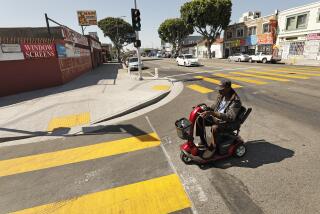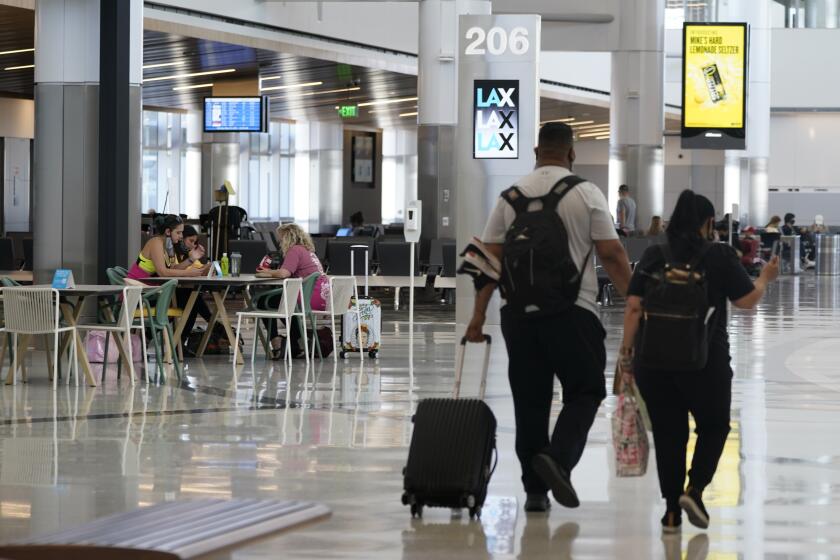In Setting the Timing of Traffic Signals, It’s Every City for Itself
- Share via
Dear Street Smart:
How long do I have to wait at an intersection for the light to change? Here in Irvine, there are several intersections that are set at an abnormally long time before the light changes.
Earle G. Wolfrom
Irvine
In California, no law limits the timing of traffic signals. There are no federal guidelines, either. It’s every city or county for itself.
In Irvine, if the signal is operating correctly, the longest wait should be 114 seconds, said Bonnie Burton, senior transportation analyst for the city. But a red light of that length would be extremely rare, she said.
The longest cycle length for all traffic signals in Irvine is 120 seconds, Burton said. This means a signal goes through all its light changes and allows time for every direction of traffic to make a move, she said.
If the traffic signal detector loops are not functioning, the malfunctioning light would remain red for 15 minutes, Burton said. Then the signal automatically realizes something is wrong and goes through a series of light changes, she said.
Dear Street Smart:
We have a dangerous traffic problem since the opening of the extension of Cabot Road from Pacific Park Drive to Crown Valley Parkway. Cabot Road is effectively an extension of Interstate 5, with heavy traffic routinely traveling at freeway speeds.
The problem is access to Cabot Road exiting from Moulton Ranch via Vista Viejo, and attempting to turn left across four lanes of high-speed traffic. There are several hundred cars exiting each day, especially during rush hour.
A traffic light is desperately needed at the intersection of Vista Viejo and Cabot to slow down traffic and allow safe entry onto Cabot. High-speed traffic coming down the hill from Crown Valley has limited visibility of traffic entering from Vista Viejo. Traffic heading toward Crown Valley is also coming downhill at a high rate of speed.
Please note that it took a fatal accident at our other entrance (Bridlewood Drive at Pacific Park) for a light to be installed. I’d like to see this avoided this time.
Frank Marangell
Laguna Hills
Shirley Land, traffic engineer for Mission Viejo, said her city did monitor the intersection of Cabot Road and Vista Viejo because of the changes in volume and speed on Cabot, along with evaluations of all the city’s intersections. That intersection ranked seventh in priority, and funds are available for only the top two priorities, Land said.
But Laguna Hills and Mission Viejo have joined forces to petition the county for money for a light there, she said. A letter was sent to the county earlier this month. County traffic engineer Ignacio Ochoa said this kind of request is usually answered within one month, after the county has a chance to do its own traffic evaluation of the intersection.
Dear Street Smart:
Do the local police departments or the Department of Motor Vehicles do anything about forcing out-of-state drivers to purchase California plates once they’ve established residency in California?
Danny J. Dempsey
Huntington Beach
A new arrival has 20 days to register a car and get new license plates from the California Department of Motor Vehicles. The penalty for not doing so is hefty. Late fees begin accruing immediately and if you’re more than a year late, the cost of registration also racks up.
The DMV, the CHP and law enforcement agencies each use their own method of tracking registration scofflaws.
Whether it’s the CHP observing the same out-of-state car over and over again on the roads, or the DMV receiving input from the public, the result is essentially the same: a form letter or notice to errant vehicle owners apprising them of the law and telling them how to make amends.
If you know of out-of-state vehicles with owners who are legal residents of California, you can blow the whistle by calling the DMV’s Registration and Compliance Unit at (916) 657-6718.
Or, you can write a letter to the Department of Motor Vehicles, Registration and Compliance Unit, P.O. Box 942869, Sacramento, Calif. 94269-0001.
In the letter include the make, model, state and license plate number of the car. In the lower left corner of the envelope write, “Unit 86A.”
More to Read
Sign up for Essential California
The most important California stories and recommendations in your inbox every morning.
You may occasionally receive promotional content from the Los Angeles Times.










